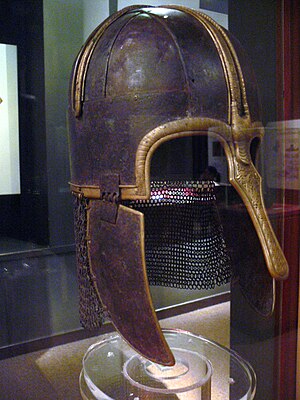Portal:Anglo-Saxon England
Anglo-Saxon England
Anglo-Saxon England or Early Medieval England covers the period from the end of Roman Britain in the 5th century until the Norman Conquest in 1066. It consisted of various Anglo-Saxon kingdoms until 927, when it was united as the Kingdom of England by King Æthelstan (r. 927–939). It became part of the short-lived North Sea Empire of Cnut, a personal union between England, Denmark and Norway, in the 11th century. The Anglo-Saxons migrated to Britain from mainland northwestern Europe after the Roman Empire's withdrawal from Britain at the beginning of the 5th century. Anglo-Saxon history thus begins during the period of sub-Roman Britain following the end of Roman control, and traces the establishment of Anglo-Saxon kingdoms in the 5th and 6th centuries (conventionally identified as seven main kingdoms: Northumbria, Mercia, East Anglia, Essex, Kent, Sussex, and Wessex); their Christianisation during the 7th century; the threat of Viking invasions and Danish settlers; the gradual unification of England under the Wessex hegemony during the 9th and 10th centuries; and ending with the Norman Conquest of England by William the Conqueror in 1066. The Normans persecuted the Anglo-Saxons and overthrew their ruling class to substitute their own leaders to oversee and rule England. However, Anglo-Saxon identity survived beyond the Norman Conquest, came to be known as Englishry under Norman rule, and through social and cultural integration with Romano-British Celts, Danes and Normans became the modern English people. (Full article...) Selected articleThe Liber Eliensis (sometimes Historia Eliensis or Book of Ely) is a 12th-century English chronicle and history, written in Latin. Composed in three books, it was written at Ely Abbey on the island of Ely in the fenlands of eastern Cambridgeshire. Ely Abbey became the cathedral of a newly formed bishopric in 1109. Traditionally the author of the anonymous work has been given as Richard or Thomas, two monks at Ely, one of whom, Richard, has been identified with an official of the monastery, but some historians hold that neither Richard nor Thomas was the author. The Liber covers the period from the founding of the abbey in 673 until the middle of the 12th century, building on a number of earlier historical works. It incorporates documents and stories of saints' lives and is a typical example of a kind of local history produced during the latter part of the 12th century, similar to a number of books written at other English monasteries. The longest of the contemporary local histories, it describes the devastation caused by the disorders during the reign of King Stephen as well an account of the career of Nigel, the Bishop of Ely from 1133 to 1169, and his disputes with King Stephen. Other themes are the miracles worked by the monastery's patron saint, Æthelthryth, and the gifts of land to Ely. The two surviving complete manuscripts of the work are complemented by a number of partial manuscripts. A printed version of the Latin text appeared in 1963 and an English translation was published in 2005, although extracts had appeared in print earlier. The Liber Eliensis is an important source of historical information for the region and period it covers, and particularly for the abbey and bishopric of Ely. (more...) Did you know?
SubcategoriesSelected imageSelected biography
Sweyn I Forkbeard (Old Norse: Sveinn Tjúguskegg; c. 960 − 3 February 1014) was king of Denmark and England, as well as parts of Norway. His name appears as Swegen in the Anglo-Saxon Chronicle. He was a Viking leader and the father of Cnut the Great. On his father Harald Bluetooth's death in late 986 or early 987, he became King of Denmark; in 1000, with allegiance of the Trondejarl, Eric of Lade, he was ruler over most of Norway. After a long effort at conquest, and shortly before his death, in 1013 he became the first of the Danish Kings of England. (more...) Things you can do
Featured articles and lists
Related portalsWikiProjects
Associated WikimediaThe following Wikimedia Foundation sister projects provide more on this subject:
| |||||||||||||||||||














